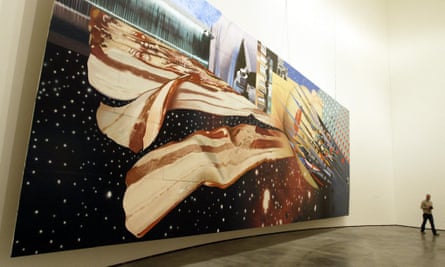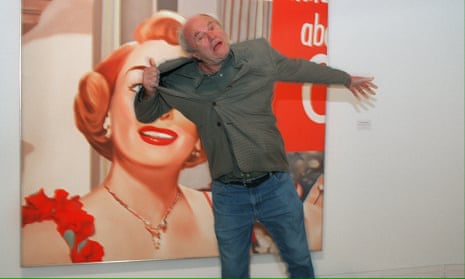The artist James Rosenquist has died, it was announced on Saturday. He was 83.
With Andy Warhol and Roy Lichtenstein, Rosenquist was a pioneer of pop art, the 1960s movement that made high art out of flat, bright representations of everyday items and images, often plucked from advertising and media. Such works proved immensely popular and helped to change the nature of contemporary art.
Rosenquist was born in Grand Forks, North Dakota, in 1933 and studied art at the University of Minnesota. He found work in industry and in advertising before moving to New York in the mid-1950s, there to mingle with the giants of abstract expressionism.
He shared a lower Manhattan studio with Ellsworth Kelly and Agnes Martin and mixed with other artists of the next generation, including Robert Rauschenberg and Jasper Johns.
More work as a billboard painter contributed to the look and scale of his work as an artist, in which signature forms included writhing pasta, cars and home appliances.
In his 2009 autobiography, Painting Below Zero: Notes on a Life in Art, Rosenquist wrote: “I painted billboards above every candy store in Brooklyn. I got so I could paint a Schenley whiskey bottle in my sleep.”
About the label of “pop art”, he wrote that he had “never cared for the term” but was “resigned to it”. He also sought to distinguish his work from that of Warhol and Lichtenstein, writing: “I was never concerned with logos or brand names or movie stars, like Andy, for instance. Unlike Roy, I wasn’t interested in ironic simulations of pop media; I wanted to make mysterious pictures.”
In one well-known work from 1960-61, President Elect, he painted John F Kennedy’s face alongside a yellow Chevrolet and a piece of cake.
“The face was from Kennedy’s campaign poster,” he told The Art Story. “I was very interested at that time in people who advertised themselves. Why did they put up an advertisement of themselves? So that was his face. And his promise was half a Chevrolet and a piece of stale cake.”
Speaking in his 1997 TV history of American art, American Visions, the Australian critic Robert Hughes said: “Generally there’s no politics in Rosenquist’s fantasies of desire, but in 1965 he produced an exception to that, an enormous panorama about Vietnam.”
The painting in question, Rosenquist’s most famous, is the 86ft-long F-111, a sequence of 23 panels named for a US military jet and a gallery-wrapping critique of the military-industrial complex and the American public’s complicity with it.
Rosenquist, who wrote that the size of his works “gave steroids to pop art”, spoke to Hughes for the programme.
The angel’s food cake in the painting was “a metaphor for a missile silo”, he said, adding: “I thought of this plane going through all this flak, of household items, lightbulbs in particular, imagery of things during peacetime.
“The little girl with blonde hair under a hairdryer is the pilot of this bomber, an aviatrix, and then on to a rendering of a hydrogen bomb in a red grisaille with an umbrella over it … like a view from a resort on to a nuclear bomb.”
The painting, Hughes said, “summed up Rosenquist’s vision of America as an Eden compromised by its own violence”.

Writing in Time magazine in 2001, about an exhibition at the Whitney Museum in New York, Hughes said that though F-111 “may not be, as has sometimes been claimed, the Guernica of the 60s … it affected people in a way few works of political art had done since the murals of Diego Rivera in the 1930s.
“It suited its time, just as Rosenquist’s lusher paintings of the 80s, with their candied colors and peculiarly deceitful overlays of motif – the sumptuous presentation of dying fetishes of American culture, like the space program – suit theirs.
“Rosenquist, in short, is one of the few former pop artists whose work continues unabatedly to have something to say, however elliptic the mode of saying it turns out to be.”
In 2003, Rosenquist was honoured with a full retrospective at the Guggenheim Museum in New York. In 2009, he lost paintings – including a huge mural commissioned by the French government – and property to a brush fire in Florida. His wife, Mimi Thompson, told the New York Times he died at his home in the city, after a long illness.
